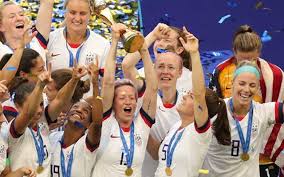July 10 –The total potential sponsorship value of women’s football globally is currently undervalued by a massive $1.2 billion globally, according brand valuation consultancy Brand Finance.
The consultancy firm says one of the reasons for disparity is the current practice of bundling men and women sponsorship into one package (UEFA has separated its men’s and women’s commercial rights). The result being that, with the rapid growth of the media profile of the women’s game and expected increased participation, the value for the women’s portion is rapidly becoming under represented in the total value.
With a changing social dynamic in the game, so should come a change in the revenue dynamic but it is one that is still struggling to filter through into the women’s game.
The cries of ‘Equal Pay’ and the boos for FIFA president Gianni Infantino that rang out around the Stade Lyonnais at the Women’s World Cup Final last Sunday are an early (but really just another) warning signal that FIFA has yet to adapt to the realities of the either the social or economic reality of a changing football world.
The winners of this year’s Women’s World Cup received double the amount of prize money compared to the 2015 winners at $4 million and an overall prize fund that also doubled to $30 million. In comparison, the winners of the next men’s World Cup will expect to take away $40 million, with total prize money reaching a staggering $440 million.
Infantino triumphantly announced that for 2023 the total prize money would be doubled to $60 million and the competition potentially expanded to 32 teams told reporters. And here lies a fundamental problem for FIFA and Infantino in particular. While the women’s prize money is increasing so, significantly, is the gap between the men and women.
With sponsors increasingly looking at integrity issues, Infantino has just raised a huge red flag for anyone looking to invest their sponsorship dollars and expecting some measure of gender parity in that marketing investment. Certainly they will not be getting it within Infantino’s FIFA. The boos and brickbats aimed at him are only likely to increase from a women’s game that, led by the American women, is not prepared to remain as subservient and manipulable as he would like.
So, ultimately the issue for international women’s game at its highest profile and performance level is that it might not be positioned to pick up a chunk of the $1.2 billion that Brand Finance says is being left on the table. That is money that should logically drip back into the women’s globally, though would not under FIFA’s current budget structure.
David Haigh, CEO of Brand Finance, commented: “It is clear that there is a monumental gap in the market for women’s football sponsorship. Recent deals, including Visa’s seven-year contract with UEFA and Lucozade’s support of the English Lionesses, are steps in the right direction to utilise the rise in popularity of the sport. As the women’s game gains more attention globally, following the success of the 2019 World Cup, we will no doubt see a more permanent shift in the business dynamic as well as the social dynamic of football.”
The viewing figures are another reflection of the disparity in the funding allocations. The FIFA men’s World Cup had a total viewing audience of 3.5 billion. France 2019 total viewing audience is expected to be about 1 billion
However, in key big money, broadcast rights buying markets (the US and UK in particular) the France 2019 World Cup is either matching, or in the US, beating the figures for the men’s game. It is a set of numbers that will ask big budget questions of the game’s male leadership.
Bryn Anderson, Sports Valuation Director at Brand Finance, said: “As viewership normally determines the magnitude of sponsorship deals and prize pots, the World Cup should be a catalyst for a business revolution in the women’s game.”
Note the words “should be.”
Contact the writer of this story at moc.l1745675446labto1745675446ofdlr1745675446owedi1745675446sni@n1745675446osloh1745675446cin.l1745675446uap1745675446

